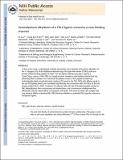| dc.contributor.author | Liu, Fa | |
| dc.contributor.author | Park, Jung-Eun | |
| dc.contributor.author | Qian, Wen-Jian | |
| dc.contributor.author | Gräber, Martin | |
| dc.contributor.author | Berg, Thorsten | |
| dc.contributor.author | Lee, Kyung S. | |
| dc.contributor.author | Lim, Daniel Cham-Chin | |
| dc.contributor.author | Yaffe, Michael B | |
| dc.contributor.author | Burke, Terrence R. | |
| dc.date.accessioned | 2012-11-28T18:01:30Z | |
| dc.date.available | 2012-11-28T18:01:30Z | |
| dc.date.issued | 2011-07 | |
| dc.date.submitted | 2010-12 | |
| dc.identifier.issn | 1552-4450 | |
| dc.identifier.issn | 1552-4469 | |
| dc.identifier.uri | http://hdl.handle.net/1721.1/75076 | |
| dc.description.abstract | We obtained unanticipated synthetic byproducts from alkylation of the δ[superscript 1] nitrogen (N3) of the histidine imidazole ring of the polo-like kinase-1 (Plk1) polo-box domain (PBD)-binding peptide PLHSpT. For the highest-affinity byproduct, bearing a C[subscript 6]H[subscript 5](CH[subscript 2])[subscript 8]– group, a Plk1 PBD cocrystal structure revealed a new binding channel that had previously been occluded. An N-terminal PEGylated version of this peptide containing a hydrolytically stable phosphothreonyl residue (pT) bound the Plk1 PBD with affinity equal to that of the non-PEGylated parent but showed markedly less interaction with the PBDs of the two closely related proteins Plk2 and Plk3. Treatment of cultured cells with this PEGylated peptide resulted in delocalization of Plk1 from centrosomes and kinetochores and in chromosome misalignment that effectively induced mitotic block and apoptotic cell death. This work provides insights that might advance efforts to develop Plk1 PBD-binding inhibitors as potential Plk1-specific anticancer agents. | en_US |
| dc.description.sponsorship | National Institutes of Health (U.S.) (Grant GM60594) | en_US |
| dc.description.sponsorship | National Institutes of Health (U.S.) (Grant GM68762) | en_US |
| dc.description.sponsorship | National Institutes of Health (U.S.) (Grant CA112967) | en_US |
| dc.language.iso | en_US | |
| dc.publisher | Nature Publishing Group | en_US |
| dc.relation.isversionof | http://dx.doi.org/10.1038/nchembio.614 | en_US |
| dc.rights | Creative Commons Attribution-Noncommercial-Share Alike 3.0 | en_US |
| dc.rights.uri | http://creativecommons.org/licenses/by-nc-sa/3.0/ | en_US |
| dc.source | PMC | en_US |
| dc.title | Serendipitous alkylation of a Plk1 ligand uncovers a new binding channel | en_US |
| dc.type | Article | en_US |
| dc.identifier.citation | Liu, Fa et al. “Serendipitous Alkylation of a Plk1 Ligand Uncovers a New Binding Channel.” Nature Chemical Biology 7.9 (2011): 595–601. | en_US |
| dc.contributor.department | Massachusetts Institute of Technology. Department of Biological Engineering | en_US |
| dc.contributor.department | Massachusetts Institute of Technology. Department of Biology | en_US |
| dc.contributor.department | Koch Institute for Integrative Cancer Research at MIT | en_US |
| dc.contributor.mitauthor | Lim, Dan | |
| dc.contributor.mitauthor | Yaffe, Michael B. | |
| dc.relation.journal | Nature Chemical Biology | en_US |
| dc.eprint.version | Author's final manuscript | en_US |
| dc.type.uri | http://purl.org/eprint/type/JournalArticle | en_US |
| eprint.status | http://purl.org/eprint/status/PeerReviewed | en_US |
| dspace.orderedauthors | Liu, Fa; Park, Jung-Eun; Qian, Wen-Jian; Lim, Dan; Gräber, Martin; Berg, Thorsten; Yaffe, Michael B; Lee, Kyung S; Burke, Terrence R | en |
| dc.identifier.orcid | https://orcid.org/0000-0002-9547-3251 | |
| mit.license | OPEN_ACCESS_POLICY | en_US |
| mit.metadata.status | Complete | |
